MICROSCOPE-ANTIQUES.COM © 2013-15.
BULLOCH MICROSCOPE
1880
SIGNED: W.H. BULLOCH, CHICAGO
SERIAL NUMBER: 138
MODEL: PROFESSIONAL
CLICK ON ANY PICTURE TO ENLARGE
DESCRIPTION:
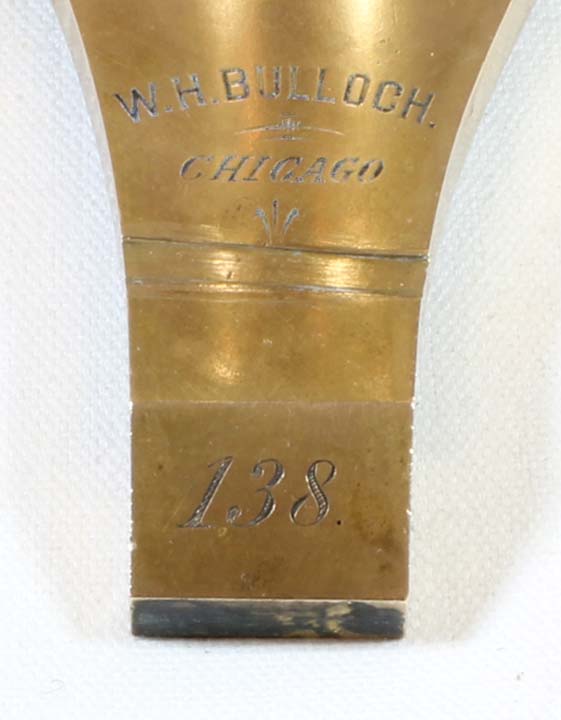
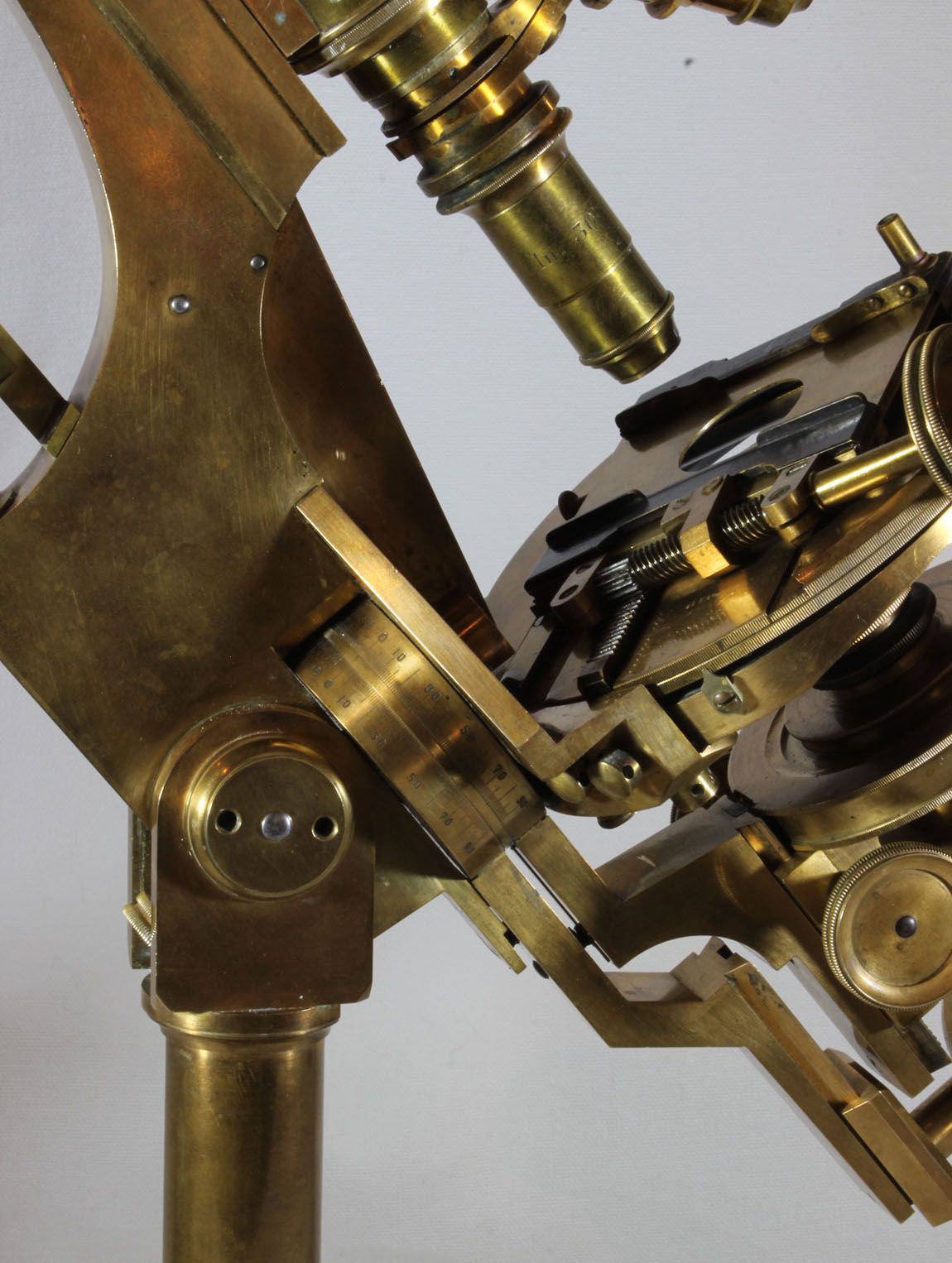
Signed in capital block letters on the Foot: W.H.Bulloch, Chicago
and on the edge of the foot, 138
. In Addition, signed on the compact iris assembly screwed into the top of the condenser fittings
Sidle & Poalk, Phila.
There is a deep groove, cut on an angle, on the foot, distal to the signature. This would originally have read 'PAT'D 1879' as can be seen on number 132. The double objective changer attached to the nosepiece is signed 'Bausch & Lomb Optical Co.'
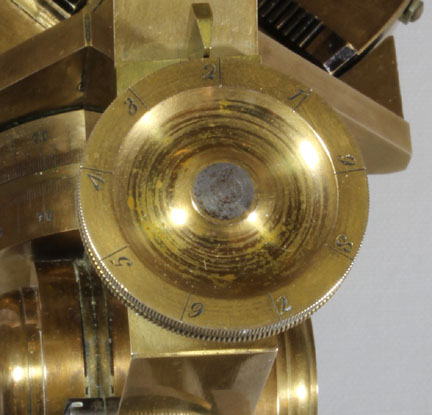 It has a flat tripod foot with 3 'claws'. The single pillar is screwed to the foot and is designed to rotate.
It has a flat tripod foot with 3 'claws'. The single pillar is screwed to the foot and is designed to rotate.
The lister limb sits between two
trunions at the top of the pillar. Coarse focus is by straight rack and pinion,
fine by long lever screw. The fine focus knob is divided, 1 to 9.
The stage support ring attaches to a 'saddle' fitting by four screws in the
back and two underneath it. The saddle itself attaches by two
screws to the front of the limb; in addition an angled support from higher on the limb comes down and attaches to the saddle with two screws from the
front.
Rotating through an axis designed to be even with the specimen being studied are two substage tailpieces. Their rings are are engraved from zero
to ninety degrees
in each direction in one degree increments, with numbering every twenty degrees. Each tailpiece can rotate separately although only the mirror support
can rotate above the stage. There are stops to register them so they
can be easily rotated as one unit, and there is a stop for the fully vertical downward position. The mirror support rides up or down on a push-pull
adjusted dovetail fitting. The gimballed mirror is concave on one side and flat on the other.
The substage assembly is also on a dovetail, and is focused by a straight rack and pinion. The condenser assembly has two portions. The upper part has a society thread to accept an objective as a condenser or the Siddle and Poalk iris now present. Below the centerable fitting is a Nicol prism housing on a separate support from the side.
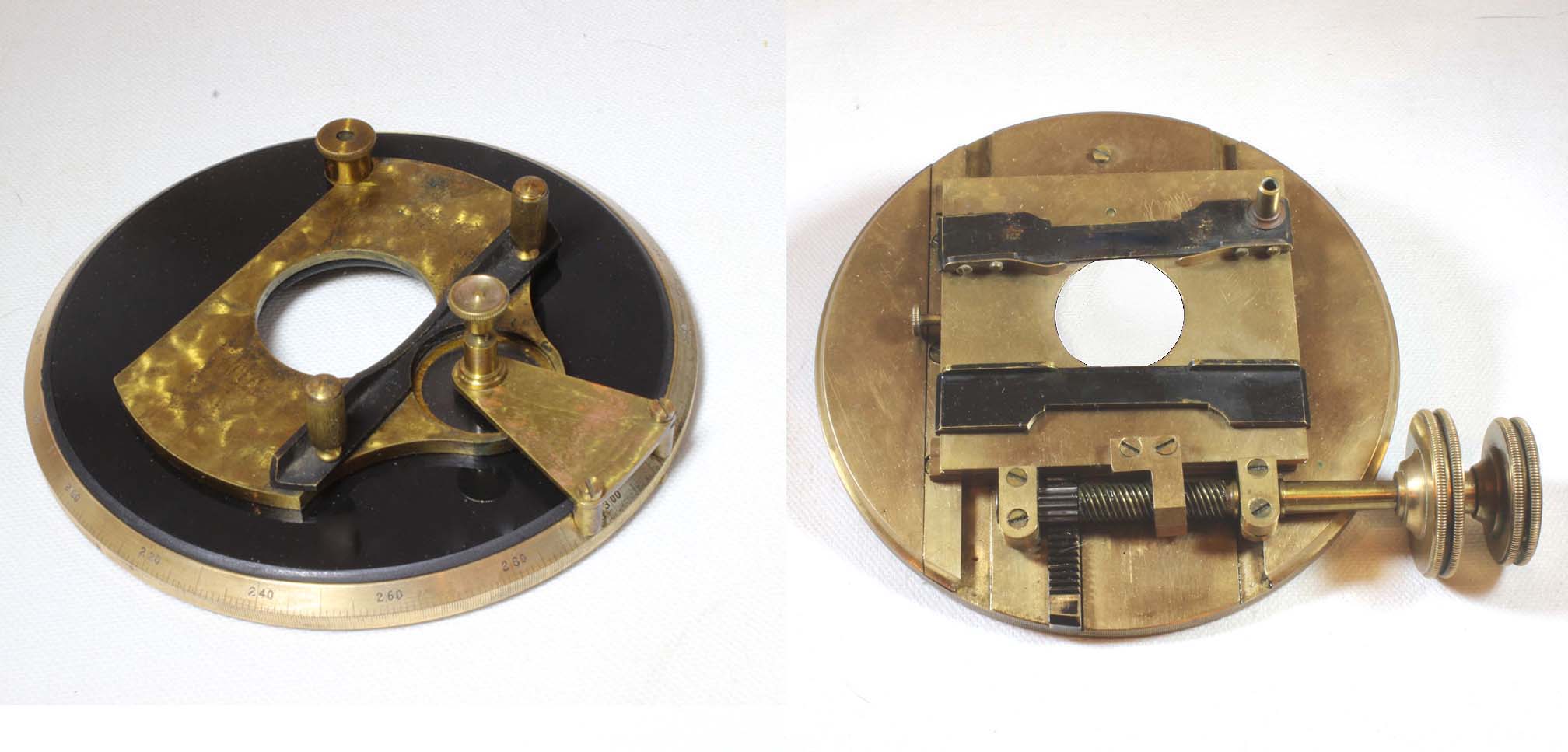 There are two rotating stages. One is a simple stage, with a glass
surface, with a beveled and silvered edge, calibrated in one degree increments, and numbered every twenty degrees. There is a a pointer on the right
rear of the stage support ring to register the degree scale. This calibrated simple stage has an attached pressure fitting to support a gliding slide support similar to that originally designed by Zentmayer. The tip of this support is made of ivory. The gliding slide support for this stage was nearly identical to a Beck slide holder from the same era; a Beck slide holder is now with the instrument; they are the same size and were finished the same way with only minute differences between the two. This simple stage has four concentric circles
engraved on the brass surface under the glass.
There are two rotating stages. One is a simple stage, with a glass
surface, with a beveled and silvered edge, calibrated in one degree increments, and numbered every twenty degrees. There is a a pointer on the right
rear of the stage support ring to register the degree scale. This calibrated simple stage has an attached pressure fitting to support a gliding slide support similar to that originally designed by Zentmayer. The tip of this support is made of ivory. The gliding slide support for this stage was nearly identical to a Beck slide holder from the same era; a Beck slide holder is now with the instrument; they are the same size and were finished the same way with only minute differences between the two. This simple stage has four concentric circles
engraved on the brass surface under the glass.
The second stage is a mechanical stage with concentric controls oriented horizontally. Movement in the left-right
axis is controlled by
worm screw, whereas the forward-backward movement is via a straight rack and pinion.
There are two blackened slide holders, with one having a fitting to accept a stage forceps.
This type of mechanical stage was Bulloch's earlier version, his later version had short vertical controls
allowing the stage to continuously rotate; the protruding controls
on this earlier stage limit travel to about 300 degrees. On the front of the stage support ring is a knurled knob to control the tension on the stage
rotation.
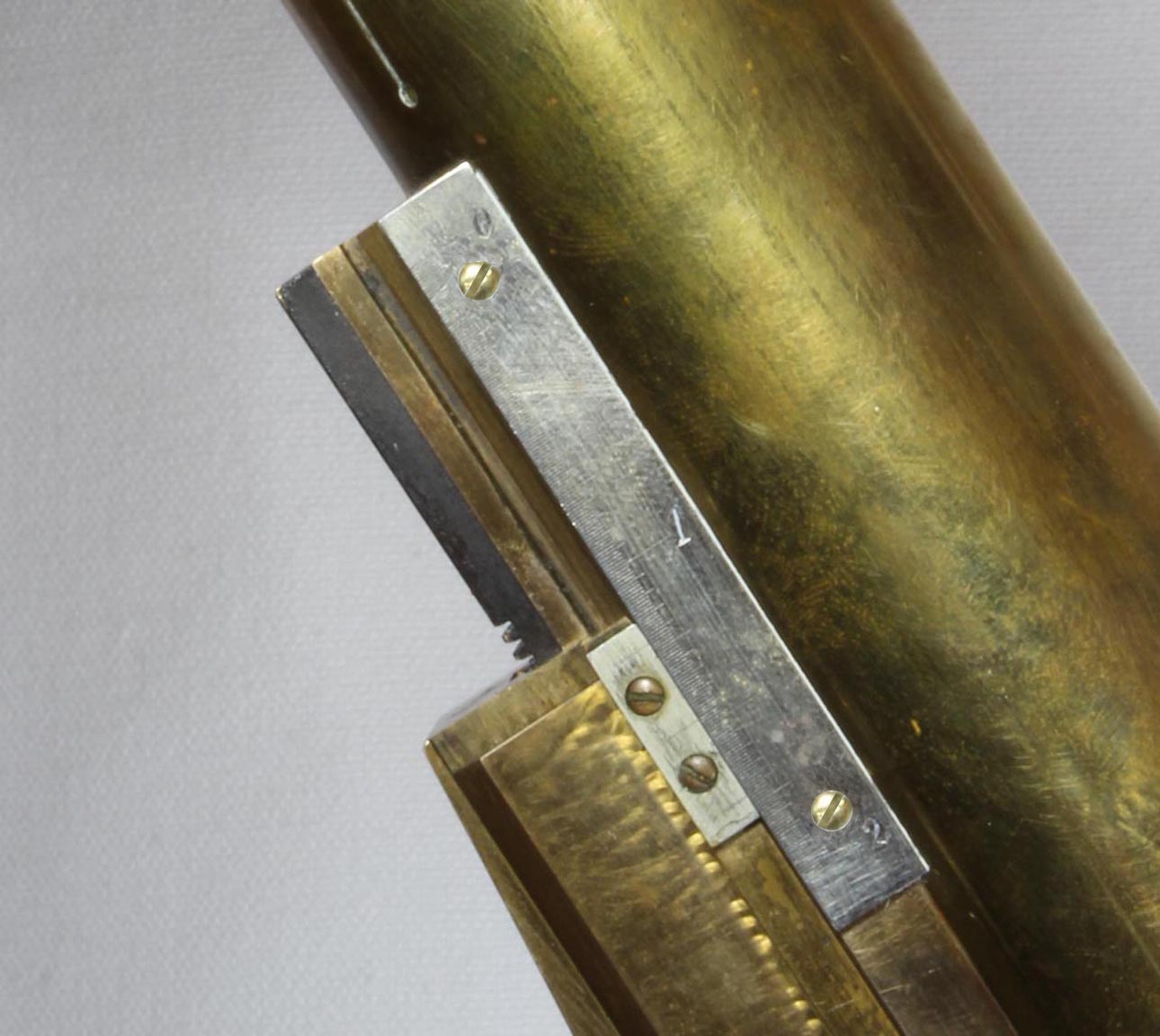
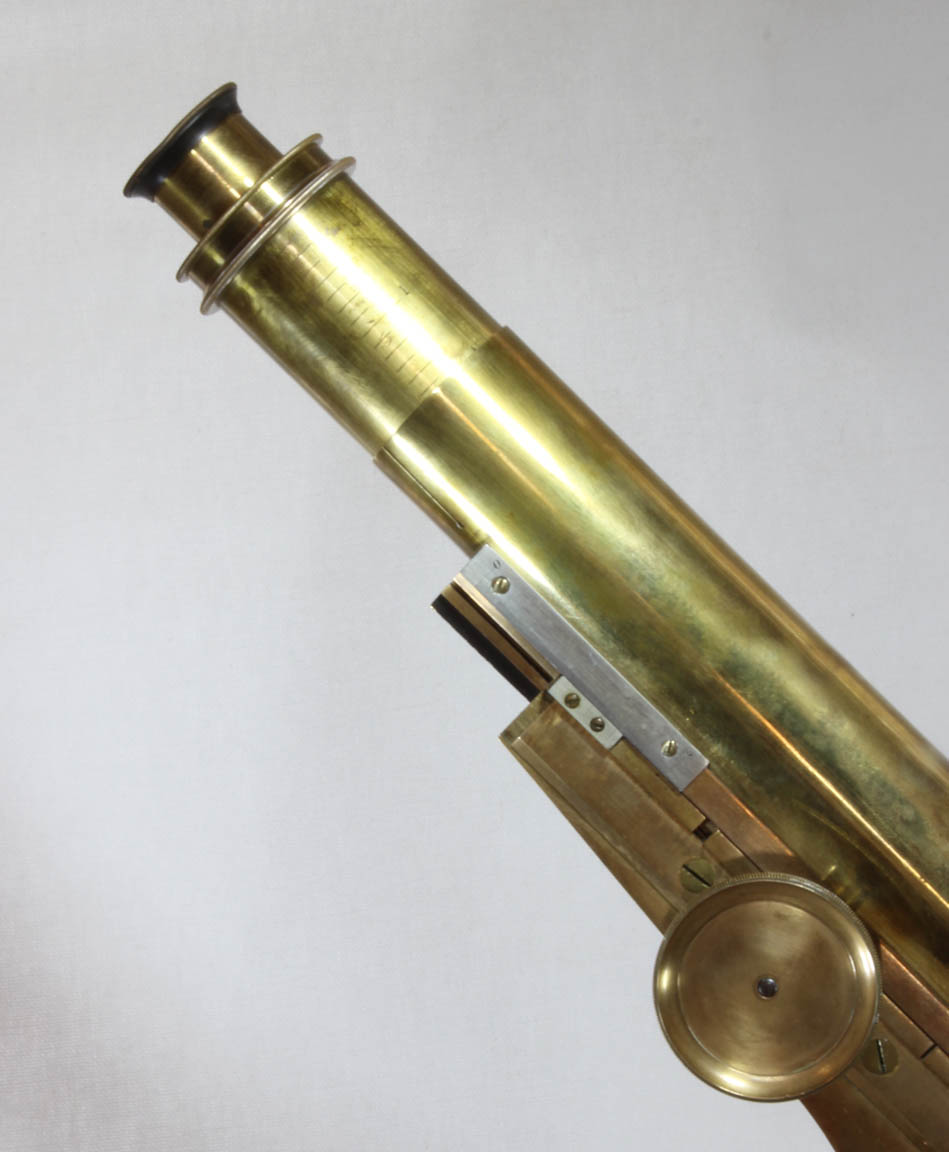 The optical tube is approximately eight inches long with the draw tube fully inside and without an eyepiece or objective; the draw tube is
calibrated from zero to six inches in 1/8th inch increments, numbered every whole inch. The inside of the lower five inches of the draw tube is
lined with black velvet inside a cardboard tube. On the right side of the instrument, there is a very finely engraved nickel-silver scale
to indicate the position of the optical tube. It is divided in hundreths of an inch and labelled at one inch intervals with the numerals '0', '1' and '2'.
The nosepiece is on a relatively short sprung fitting, constituting a 'safety' nosepiece which helps to prevent racking the objective down through
the slide.
A double nosepiece changer is signed 'Bausch & Lomb Optical Co.'
The optical tube is approximately eight inches long with the draw tube fully inside and without an eyepiece or objective; the draw tube is
calibrated from zero to six inches in 1/8th inch increments, numbered every whole inch. The inside of the lower five inches of the draw tube is
lined with black velvet inside a cardboard tube. On the right side of the instrument, there is a very finely engraved nickel-silver scale
to indicate the position of the optical tube. It is divided in hundreths of an inch and labelled at one inch intervals with the numerals '0', '1' and '2'.
The nosepiece is on a relatively short sprung fitting, constituting a 'safety' nosepiece which helps to prevent racking the objective down through
the slide.
A double nosepiece changer is signed 'Bausch & Lomb Optical Co.'
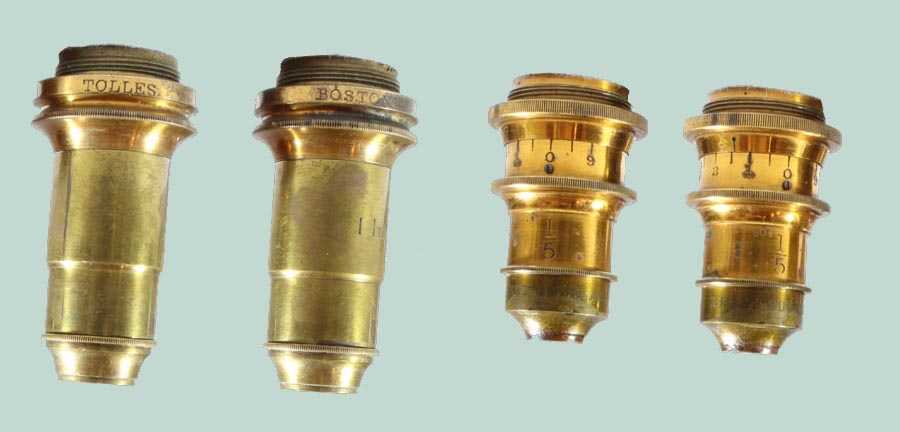
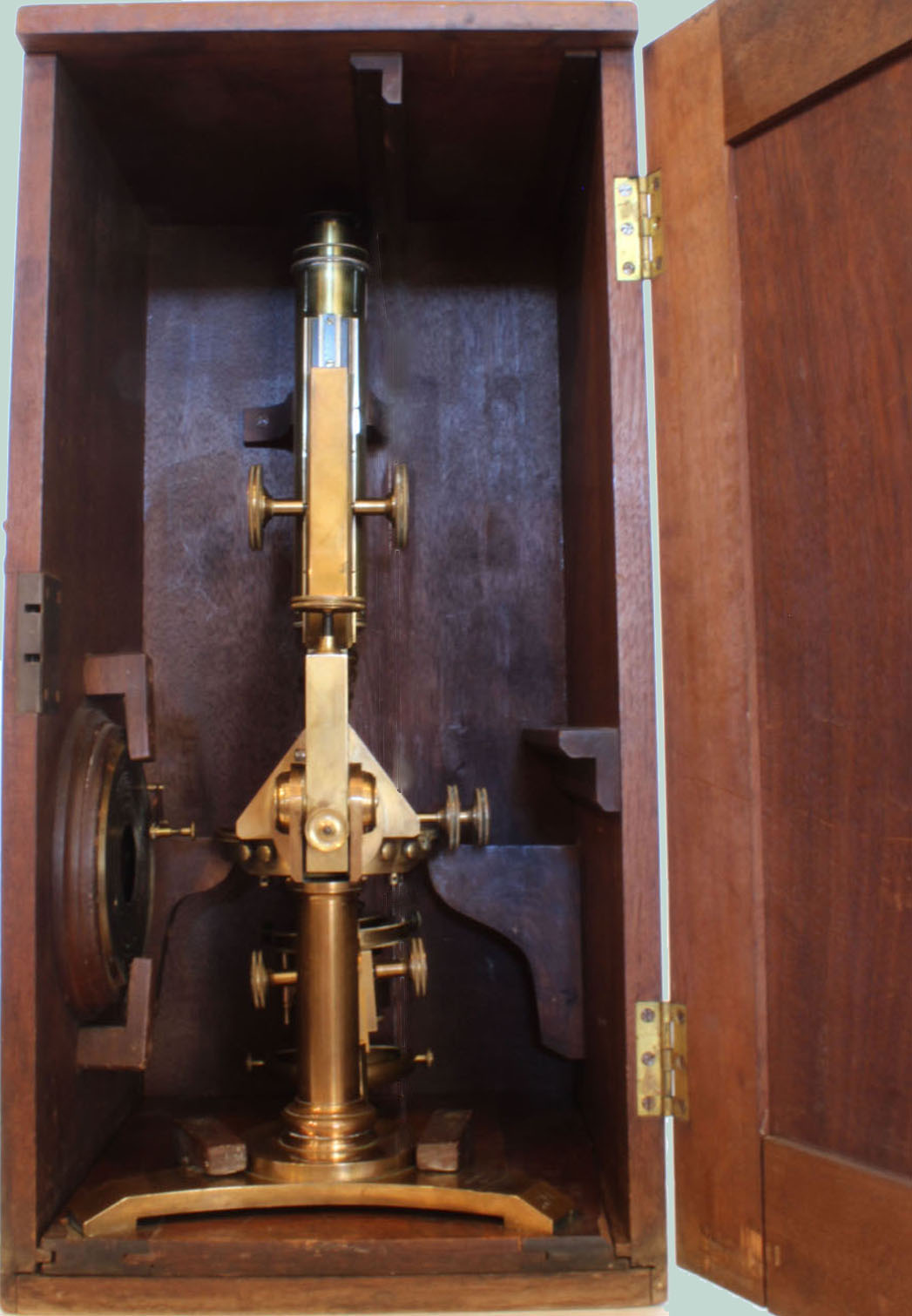
Optical components include a single eyepiece (unsigned), and two objectives. The first objective is signed 'Tolles Boston' on the rim near the threads, and '1 in. .30' on the barrel. The second objective is signed on one side of the barrel 'D' and on the other side ' ⅕ ' (1/5); it is signed on
the tip 'Ernst Gundlach.' The latter is a higher power lens with a calibrated correction collar.
This microscope has its
original hardwood box, with a wooden support, with cutouts for the feet, that slides out of the box. There is a fitting in the box for the extra stage,
and a place for a box of accessories (accessory box lacking).
DISCUSSION RELEVENT TO THIS MICROSCOPE:
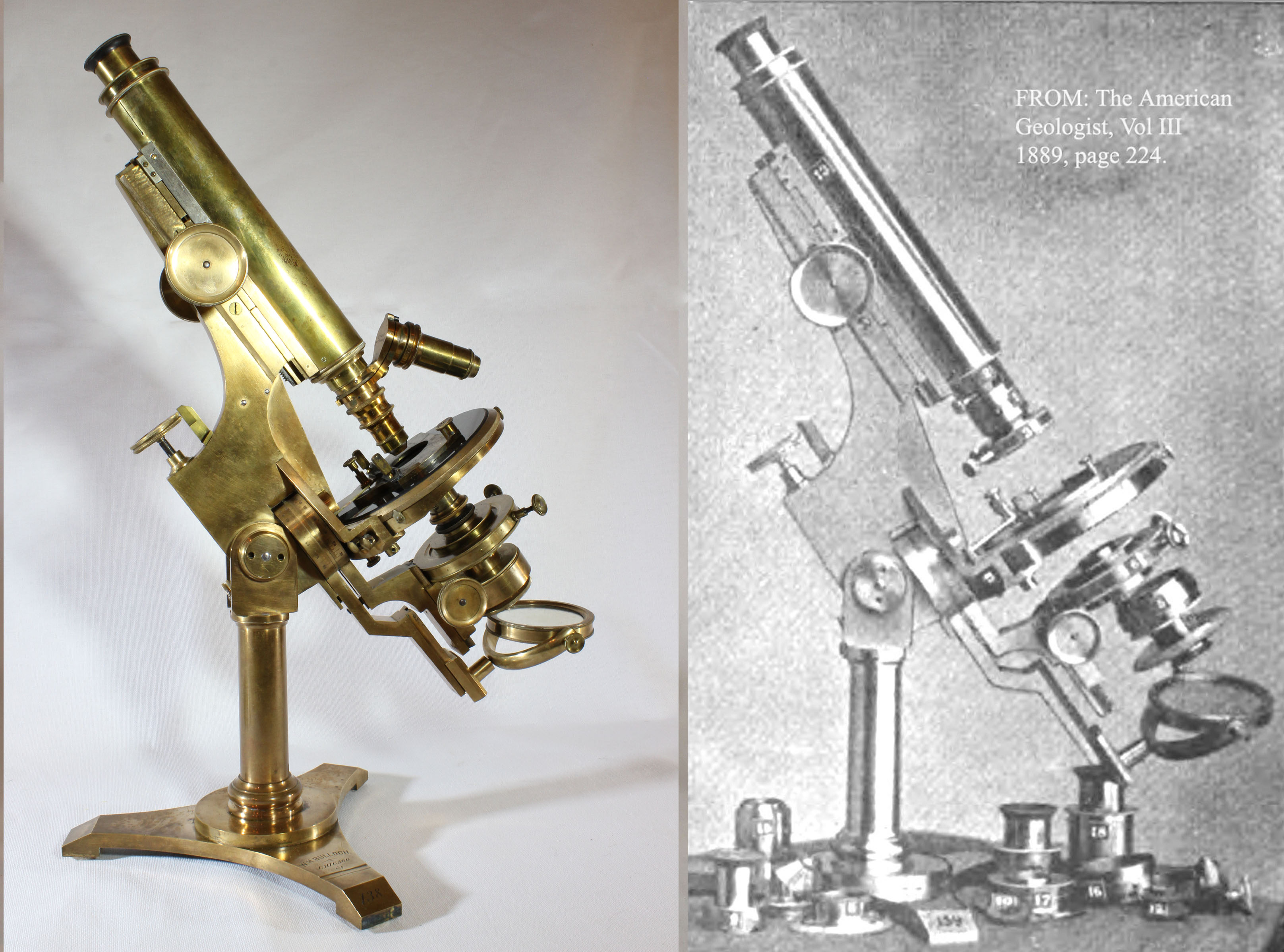 This stand, as is shown on the left, is in many ways virtually identical to number 139, the first 'Lithological' stand made by Bulloch in 1880, but is
lacking the nosepiece fittings that are distinctive to that model*.
This stand, as is shown on the left, is in many ways virtually identical to number 139, the first 'Lithological' stand made by Bulloch in 1880, but is
lacking the nosepiece fittings that are distinctive to that model*.
This stand was not shown in the 1878 catalog. It is interesting that number 132, a similar instrument, that was sold on Ebay in 2012, has a
slightly different stage arrangement, and its condenser housing is different; it has the same tailpieces as this one.
The number 138 shown here does not have the patent date, as it has been crudely removed from under the Bulloch signature on the foot
They both have fancy 'engine turned' decoration on the limb along the support for the optical tube, although in the one pictured here,
it is a bit warn down. Both of these stands are similar to number 139, the first Bulloch Lithological stand as shown here.
The use of a single pillar, instead of twin pillars continued later in the 'Professional Number Two,' the 'Biological' Models and several
other Bulloch models shown in the 1890 catalog; those single-pillar microscopes appear to be considerably smaller than the three examples (132,138, 139)
discussed here which were all from 1880. The difference is further illustrated in the image of the microscope shown here, next to the
Biological number 2, which was nearly identical in size to the Professional number 2; both were much smaller than this early Professional model.
To see a comparison of the early 'Professional,' the later version of the 'Professional,' and the 'Professional No 2,' see HERE.
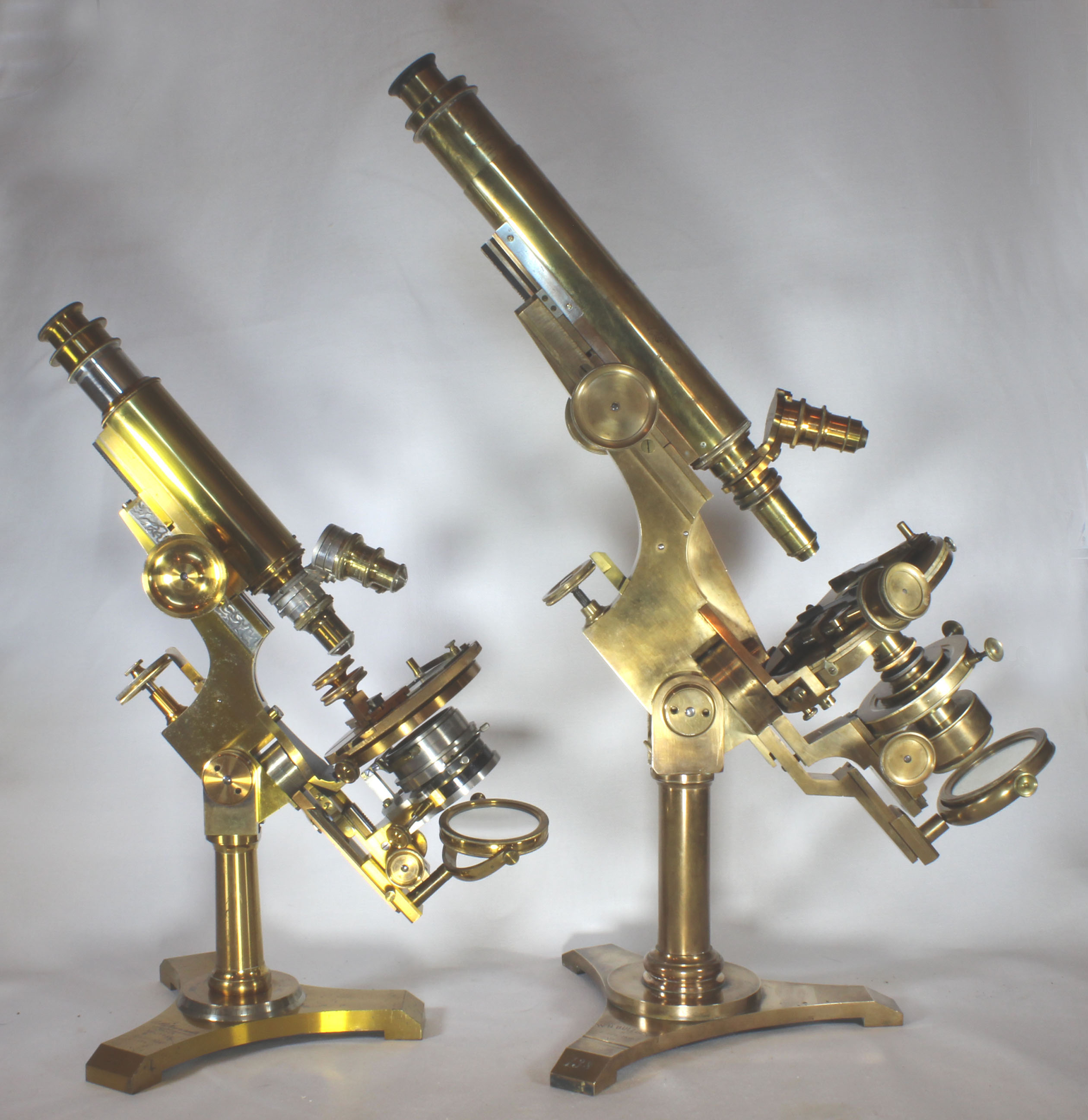 This model is much larger than the Bulloch Biological number 2, as shown in the comparison view to the right. The pillar has a slightly larger diameter, and is higher. The limb is also quite a bit larger and the saddle fitting on this microscope like the Congress model, (but unlike the Biological), has an extra support attached to the upper limb above the saddle, and comes down on an angle to reinforce the saddle
from the front. This is not a small improvment for it makes the stage support much more sturdy. Although initially all of Bulloch's tubes were the same
length, later, as shown on the right, the optical tube of the Biological number 2 was shorter. Also note the later model has a chrome plated draw tube,
while the older number 138 has a brass draw tube. The substage tailpieces for many years were 'Z' shaped but as is shown here, in later models (like the instrument on the left side of the image), the tailpieces were straight.
This model is much larger than the Bulloch Biological number 2, as shown in the comparison view to the right. The pillar has a slightly larger diameter, and is higher. The limb is also quite a bit larger and the saddle fitting on this microscope like the Congress model, (but unlike the Biological), has an extra support attached to the upper limb above the saddle, and comes down on an angle to reinforce the saddle
from the front. This is not a small improvment for it makes the stage support much more sturdy. Although initially all of Bulloch's tubes were the same
length, later, as shown on the right, the optical tube of the Biological number 2 was shorter. Also note the later model has a chrome plated draw tube,
while the older number 138 has a brass draw tube. The substage tailpieces for many years were 'Z' shaped but as is shown here, in later models (like the instrument on the left side of the image), the tailpieces were straight.
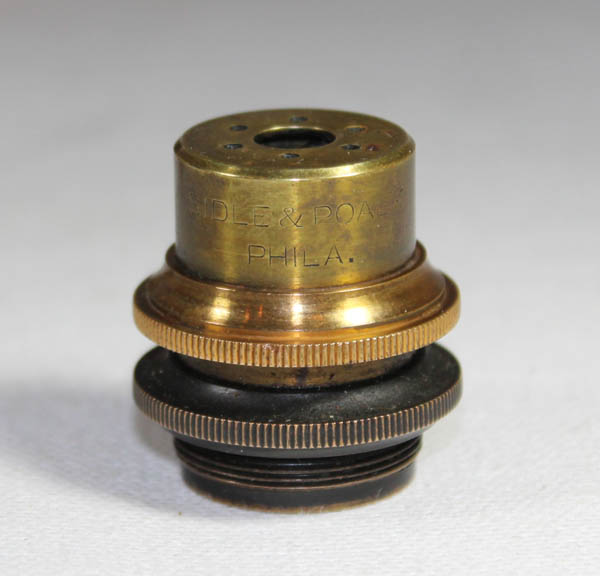
The iris attachment, which at first seems to resemble an objective, was invented by Sidle & Poalk and reported in the JRMS on page 1053 of volume III part 2, 1880, coincidentally reported about the same year this microscope was made.
The objectives with the microscope are also appropriate to the time period as Gundlach was advertising his 'New Adjustment Objectives' from Rochester in 1878,
and Tolles was producing his famous unsurpassed objectives at that time as well. Although Bulloch sold objectives made by others, he
did not make his own objectives.
*As shown in 'The American Geologist' Vol III 1889, page 225 and discussed in the article about the Bulloch Lithological microscopes
in the article that follows on pages 224-230).
HISTORY OF THE BULLOCH MICROSCOPES
Walter H Bulloch was born in Scotland and emigrated with his parents to New York as a teenager.
He was soon apprenticed to Benjamin Pike and Sons where he learned the art of fine machining (and apparently microscope design). According to Bulloch, as reported in a Presidential address in the Proceedings of Microscopical Congress of 1878, he worked for Pike 'continuously' from 1853 to 1864 eventually becomming foreman.
He soon joined in partnership with the famous objective maker William Wales, who made objectives, selling his stands with Wales objectives, and worked with him from 1864, moving to Chicago in 1866 and making his first stand in 1867. Despite the apparent work with Wales, stands by Bulloch from that time, before his move to Chicago, have not yet been identified. The reason for this is likely that they were not all signed and the features of these may not differ much from those by other makers of the time. See for instance, Bulloch No 32 which very closely resembles microscopes sold by Pike and Zentmayer. Unsigned Bulloch microscopes from his later productions have been identified, so a lack of signatures on early Bulloch microscopes would not be a suprise.
Although he initially prosperred in Chicago, the Great Chicago Fire of 1871 destroyed his premises and he never
completely recovered from this loss. To the best of my knowledge, microscopes dating from this early (pre-fire) period in Chicago have also not been firmly identified. Number 32 may date to his first year back in Chicago after the fire(1872).
Following the 1871 fire he left Chicago and went to Boston to work with the famous Robert B Tolles, inventor of the oil-immersion objective. He was back in business in Chicago by 1872, and stands dating from about 1875 have been identified.
As is evidenced by a signature on stand number 77, his agent in Chicago in that era was T. F. Nelson. T.F. Nelson apparently declared Bankruptcy in 1879 according to the
Chicago Daily Law Bulletin, volume 25.
A 1879 patent is for features of his design used on the Professional,
Biological, and 'A1' Congress stands. His design for the Congress stand was published in the Journal of the Royal Microscopical Society in 1880 and the improved version, starting about 1882 as is pictured and described on this website here.
Bulloch was elected a Fellow of the Royal Microscopical Society in December of 1882.
In 1889 he again left Chicago for a brief time
working for the U.S. Geodetic Survey as part of the Bureau of weights and measures but he again returned to Chicago after only six months with the Survey group. In the Microscopical Bulletin and Science News of December of 1890, it states that Bulloch 'has given up the manufacture of microscopes in which he was engaged in Chicago and has accepted a position in the Coast Survey'. Nevertheless. in 1891 he opened business again in Chicago, but had longstanding bad health and died in November of 1891. For a few months after his death, a M. Von Mehren took over his business, but his entire business was shortly then taken over by the 'opticians' E.B. Meyrowitz of New York City,
(who were his New York agents even well before his death), and several surviving instruments have the Meyerowitz signature on the foot. Meyrowitz went on to sell microscopes on the Bulloch pattern until at least 1894 as seen in their 1894 catalog. They modified the stands by changing to 'spiral' rack and pinion controls and making more complex condenser fittings. They also renamed the 'Biological No.2' to the 'Bulloch Bacteriological'
These stands, modified by Meyrowitz have a run of serial numbers unrelated to Bulloch's own numbers and these Meyrowitz serial numbers cannot be used to date those stands.
As noted above, there is no record known to the author of Bulloch ever making his own objectives. However Bulloch made impressive stands,
especially his Congress stand, the Professional, Lithological, and the Biological Number 2.
Bulloch made relatively few stands compared to
many other well-known makers. This is in part due to the limited time he was in business, and the fact that he was
a perfectionist. Anyone who has had the priviledge of handling Bulloch instruments cannot help but admire his quality of workmanship and his very sound designs.
The author would like to acknowledge the help of Allan Wissner, Paul Ferraglio, John P. Trier, Joe Zeligs, and others who have helped clarify several issues as well as help me realize some errors I had first made when preparing this page. I am always greatful to all my good friends in the microscopy world who share their knowledge and keen powers of observation with me. I would welcome further input from any reader as well.


 It has a flat tripod foot with 3 'claws'. The single pillar is screwed to the foot and is designed to rotate.
It has a flat tripod foot with 3 'claws'. The single pillar is screwed to the foot and is designed to rotate.  There are two rotating stages. One is a simple stage, with a glass
surface, with a beveled and silvered edge, calibrated in one degree increments, and numbered every twenty degrees. There is a a pointer on the right
rear of the stage support ring to register the degree scale. This calibrated simple stage has an attached pressure fitting to support a gliding slide support similar to that originally designed by Zentmayer. The tip of this support is made of ivory. The gliding slide support for this stage was nearly identical to a Beck slide holder from the same era; a Beck slide holder is now with the instrument; they are the same size and were finished the same way with only minute differences between the two. This simple stage has four concentric circles
engraved on the brass surface under the glass.
There are two rotating stages. One is a simple stage, with a glass
surface, with a beveled and silvered edge, calibrated in one degree increments, and numbered every twenty degrees. There is a a pointer on the right
rear of the stage support ring to register the degree scale. This calibrated simple stage has an attached pressure fitting to support a gliding slide support similar to that originally designed by Zentmayer. The tip of this support is made of ivory. The gliding slide support for this stage was nearly identical to a Beck slide holder from the same era; a Beck slide holder is now with the instrument; they are the same size and were finished the same way with only minute differences between the two. This simple stage has four concentric circles
engraved on the brass surface under the glass. 
 The optical tube is approximately eight inches long with the draw tube fully inside and without an eyepiece or objective; the draw tube is
calibrated from zero to six inches in 1/8th inch increments, numbered every whole inch. The inside of the lower five inches of the draw tube is
lined with black velvet inside a cardboard tube. On the right side of the instrument, there is a very finely engraved nickel-silver scale
to indicate the position of the optical tube. It is divided in hundreths of an inch and labelled at one inch intervals with the numerals '0', '1' and '2'.
The nosepiece is on a relatively short sprung fitting, constituting a 'safety' nosepiece which helps to prevent racking the objective down through
the slide.
A double nosepiece changer is signed 'Bausch & Lomb Optical Co.'
The optical tube is approximately eight inches long with the draw tube fully inside and without an eyepiece or objective; the draw tube is
calibrated from zero to six inches in 1/8th inch increments, numbered every whole inch. The inside of the lower five inches of the draw tube is
lined with black velvet inside a cardboard tube. On the right side of the instrument, there is a very finely engraved nickel-silver scale
to indicate the position of the optical tube. It is divided in hundreths of an inch and labelled at one inch intervals with the numerals '0', '1' and '2'.
The nosepiece is on a relatively short sprung fitting, constituting a 'safety' nosepiece which helps to prevent racking the objective down through
the slide.
A double nosepiece changer is signed 'Bausch & Lomb Optical Co.' 

 This stand, as is shown on the left, is in many ways virtually identical to number 139, the first 'Lithological' stand made by Bulloch in 1880, but is
lacking the nosepiece fittings that are distinctive to that model*.
This stand, as is shown on the left, is in many ways virtually identical to number 139, the first 'Lithological' stand made by Bulloch in 1880, but is
lacking the nosepiece fittings that are distinctive to that model*.  This model is much larger than the Bulloch Biological number 2, as shown in the comparison view to the right. The pillar has a slightly larger diameter, and is higher. The limb is also quite a bit larger and the saddle fitting on this microscope like the Congress model, (but unlike the Biological), has an extra support attached to the upper limb above the saddle, and comes down on an angle to reinforce the saddle
from the front. This is not a small improvment for it makes the stage support much more sturdy. Although initially all of Bulloch's tubes were the same
length, later, as shown on the right, the optical tube of the Biological number 2 was shorter. Also note the later model has a chrome plated draw tube,
while the older number 138 has a brass draw tube. The substage tailpieces for many years were 'Z' shaped but as is shown here, in later models (like the instrument on the left side of the image), the tailpieces were straight.
This model is much larger than the Bulloch Biological number 2, as shown in the comparison view to the right. The pillar has a slightly larger diameter, and is higher. The limb is also quite a bit larger and the saddle fitting on this microscope like the Congress model, (but unlike the Biological), has an extra support attached to the upper limb above the saddle, and comes down on an angle to reinforce the saddle
from the front. This is not a small improvment for it makes the stage support much more sturdy. Although initially all of Bulloch's tubes were the same
length, later, as shown on the right, the optical tube of the Biological number 2 was shorter. Also note the later model has a chrome plated draw tube,
while the older number 138 has a brass draw tube. The substage tailpieces for many years were 'Z' shaped but as is shown here, in later models (like the instrument on the left side of the image), the tailpieces were straight.
